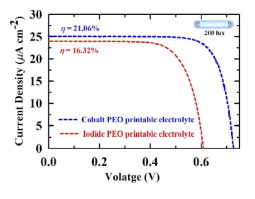Chemical Engineering Journal ( IF 15.1 ) Pub Date : 2020-04-05 , DOI: 10.1016/j.cej.2020.124954 Shanmuganathan Venkatesan , I-Ping Liu , Chih-Mei Tseng Shan , Hsisheng Teng , Yuh-Lang Lee

|
High-performance printable electrolytes (PEs) containing Co+2/Co+3 or I-/I3- redox-couple are prepared to fabricate quasi-solid-state (QS) dye-sensitized solar cells (QS-DSSCs) for room light environment applications. Polyethylene oxide (PEO) and poly(methyl methacrylate) (PMMA) are utilized to prepare PEs. Various parameters are regulated to obtain the optimal power conversion efficiencies (PCEs). For the I-/I3- system, the QS-DSSCs using PEO and PEO/PMMA PEs achieve nearly identical PCEs (16.32% and 16.40%, respectively) under the optimal conditions. However, the PCEs obtained for the Co+2/Co+3 system are markedly higher and the cell using PEO PE has a higher PCE (21.06%) than that using PEO/PMMA (18.14%). This difference is ascribed to the different composition of Li+ and Co+3 around the photoelectrode. The presence of Li+ around the interface will repel Co+3 away from the interface, decreasing the recombination of excited electrons to Co+3. According to the molecular structure, PMMA has more lone pair electrons to coordinate with Li+ ions, which will decrease the concentration of free Li+ more significantly than does by PEO. Therefore, the presence of PMMA will decrease and increase, respectively, the Li+ and Co+3 concentrations at the photoelectrode/electrolyte interface, resulting in more significant recombination of electrons to the Co+3. Consequently, the PCE of the PEO/PMMA cell is lower than that of the PEO cell. This effect doesn’t occur in I-/I3- system because the concentration variation of negatively charged ions did not affect significantly the electrons recombination at the interfacial. By using this cobalt PE, a bifacial QS-DSSC can achieve PCEs of 17.22% and 14.25%, respectively, under front-side and back-side illumination by 200 lux T5 light. A sub-module QS-DSSC using the cobalt PE can attain a PCE of 12.56%.
中文翻译:

使用基于聚环氧乙烷钴的可印刷电解质的高效室内光准固态染料敏化太阳能电池
高性能可印刷电解质含有Co(PES)2 / Co的3或I - / I 3 -氧化还原对制备以制造准固态(QS)染料敏化用于房间太阳能电池(QS-DSSC中)轻环境应用。聚环氧乙烷(PEO)和聚甲基丙烯酸甲酯(PMMA)用于制备PE。调节各种参数以获得最佳功率转换效率(PCE)。对于I - / I 3 -系,使用PEO和PEO / PMMA PE上的QS-DSSC中达到在最佳条件下几乎相同的PCE(分别为16.32%和16.40%)。但是,对于Co +2 / Co +3获得的PCE与使用PEO / PMMA(18.14%)相比,使用PEO PE的电池具有更高的PCE(21.06%)。该差异归因于光电极周围的Li +和Co +3的不同组成。界面周围Li +的存在会排斥Co +3脱离界面,从而降低激发电子向Co +3的复合。根据分子结构,PMMA具有更多的孤对电子以与Li +离子配位,这将比PEO显着降低游离Li +的浓度。因此,PMMA的存在会分别减少和增加Li +和Co在光电极/电解质界面处+3浓度,导致电子更显着地重组为Co +3。因此,PEO / PMMA单元的PCE低于PEO单元的PCE。该效果也不会发生在我- / I 3 -因为带负电荷的离子的浓度变化不影响显著在界面的电子重组系统。通过使用这种钴PE,双面QS-DSSC在200 lux T5光的正面和背面照明下,可以分别实现17.22%和14.25%的PCE。使用钴PE的子模块QS-DSSC可以达到12.56%的PCE。



























 京公网安备 11010802027423号
京公网安备 11010802027423号